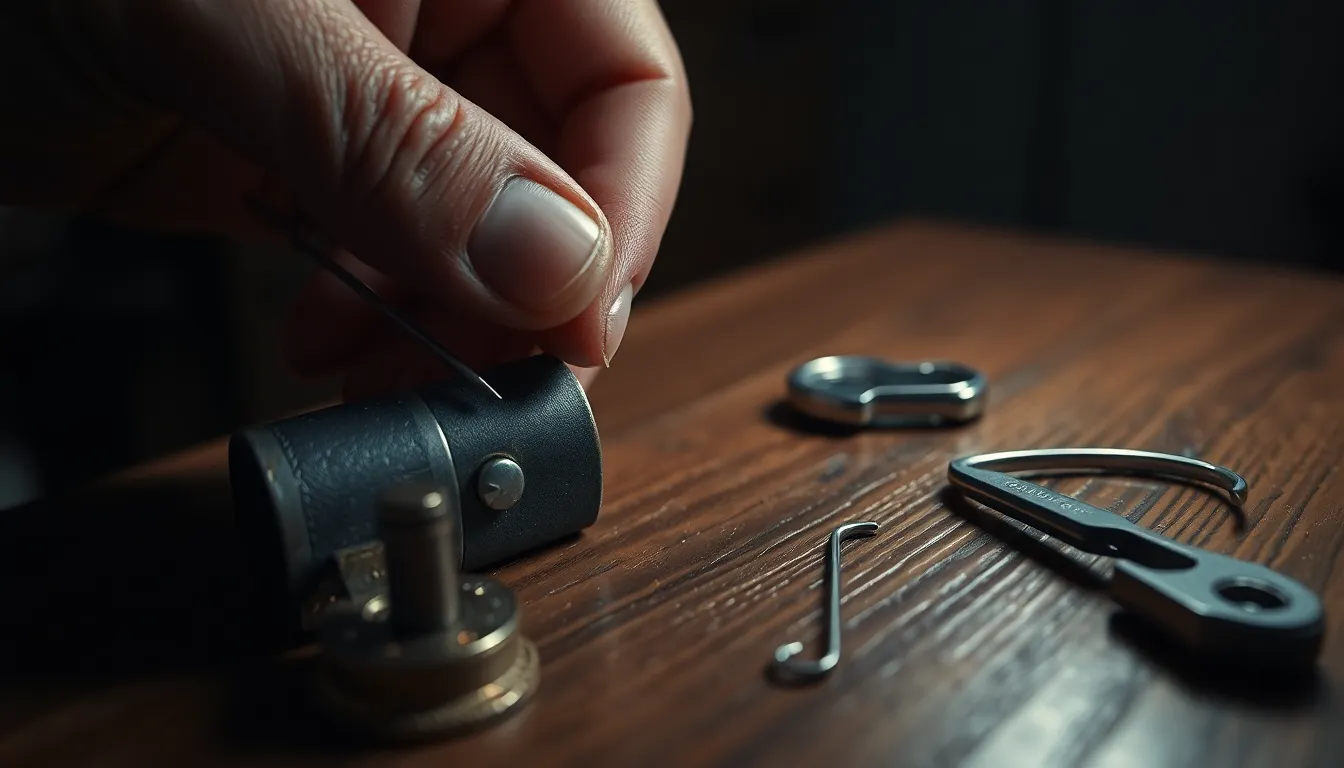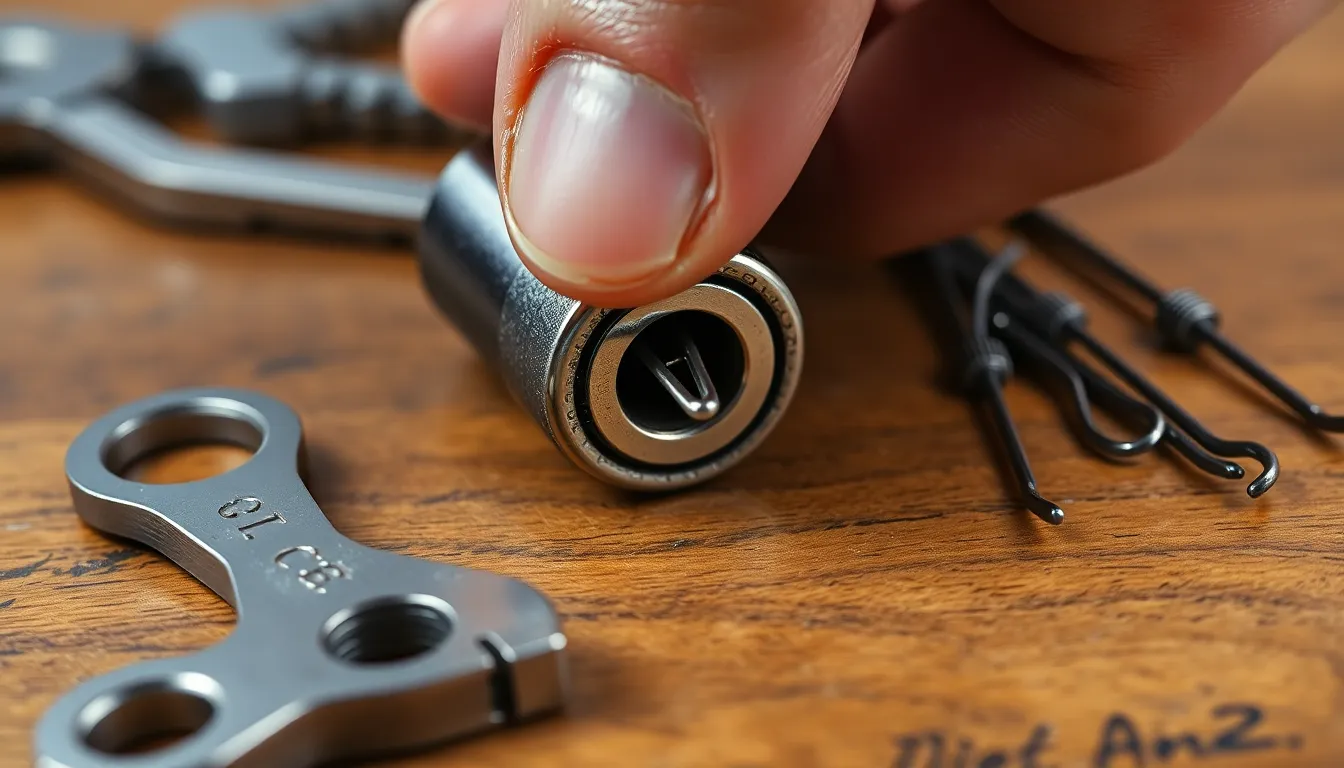Table of Contents
ToggleLock picking might seem like a skill reserved for secret agents and master thieves, but it’s more accessible than most people think. With just a simple bobby pin, anyone can learn the basics of this intriguing art. Understanding how to pick a lock not only piques curiosity but also equips individuals with a handy tool for those unexpected moments when keys go missing.
In this guide, readers will explore the fundamentals of lock picking using a bobby pin. From the necessary tools to the step-by-step techniques, it’s all about demystifying the process. Whether for practical purposes or just for fun, mastering this skill can be both rewarding and empowering.
Understanding Lock Mechanics
Understanding lock mechanics is essential for effective lock picking. Different types of locks operate on various principles, making familiarity with their design crucial for success.
Types of Locks
- Pin Tumbler Locks: These common locks use pins of varying lengths. When the correct key is inserted, the pins align, allowing the cylinder to turn.
- Wafer Locks: These locks feature flat wafers instead of pins. They operate similarly to pin tumbler locks but are easier to pick due to their design.
- Disc Detainer Locks: Disc detainers consist of rotating discs that must be correctly aligned to open. They require specific techniques for effective picking.
- Lever Locks: These locks utilize a series of levers. When the correct key engages the levers, the lock opens, making this type more secure but hard to pick.
- Electronic Locks: These modern locks employ keypads or card readers. They require a different approach, often focusing more on bypass methods than traditional picking.
How Locks Work
Locks secure doors by preventing unauthorized access, utilizing mechanical or electronic mechanisms. Here’s how they function:
- Key Insertion: When a key is inserted, it engages the internal mechanisms, such as pins or levers.
- Alignment: Mechanical components align based on the key’s shape. In pin tumbler locks, for example, the correct key pushes pins to the shear line.
- Turning Mechanism: Once components align, the cylinder or bolt can rotate. This action either retraction of the bolt or release of electronic mechanisms allows entry.
- Security Features: Many locks include security measures like anti-drill plates or reinforced components, making them harder to pick. These features may deter novice lock pickers.
Understanding these types and mechanisms helps demystify the lock picking process, ensuring effective techniques can be applied successfully.
Tools Required for Picking Locks


Lock picking requires a few essential tools for effective execution. The primary focus is on the bobby pin, but additional tools enhance the process and success rate.
The Bobby Pin
The bobby pin serves as the main tool for lock picking. This affordable and readily available item works well due to its steel composition, providing necessary strength and flexibility. To prepare a bobby pin for use, bend one end into a small hook and leave the other end straight for tensioning the lock. This simple modification allows it to manipulate the lock’s pins effectively, making it suitable for beginners learning the basic techniques.
Additional Tools
While a bobby pin can suffice, several additional tools can facilitate the lock picking process:
- Tension Wrench: A tension wrench applies rotational force to the lock. This tool is essential for maintaining pressure while working the bobby pin inside the lock.
- Hook Picks: Hook picks, available in various sizes, assist in lifting pins precisely. These tools are designed specifically for manipulating individual pins, increasing efficiency.
- Rake Picks: Rake picks offer a different technique, ideal for quickly jiggling pins into place. They cover more ground and help in quickly overcoming specific types of locks.
- File or Sandpaper: A file or sandpaper can refine the bobby pin’s shape and enhance its effectiveness. A sharper hook can improve chances of success during the picking process.
Each tool serves a unique purpose, contributing to a more effective and efficient lock picking experience.
Steps to Pick a Lock with a Bobby Pin
Following specific steps makes picking a lock with a bobby pin straightforward. Each phase focuses on precision to ensure success.
Preparing the Bobby Pin
- Straighten the bobby pin. Start by bending the wavy part down to create a straight piece of metal.
- Create a slight hook at one end. Use pliers to form a gentle curve, ideal for engaging the pins inside the lock.
- Optionally, refine the edges. Use a file or sandpaper to smooth any rough points, optimizing grip and reducing snagging in the lock.
Inserting the Bobby Pin
- Locate the lock’s keyhole. Position the bobby pin with the hooked end facing the back of the keyhole.
- Apply slight pressure while inserting. Push the bobby pin into the lock until it reaches the tension rod, avoiding aggressive force that might break the pin.
- Insert a tension wrench in the lower part of the lock. This tool aids in applying rotational force while working with the bobby pin.
Manipulating the Pins
- Apply tension using the wrench. Apply slight pressure in the direction you would turn the key, keeping the tension consistent.
- Insert the bobby pin into the keyhole. Explore different depths to uncover the various pins inside the lock.
- Feel for pin movement. As you maneuver the bobby pin, notice which pins catch or set. Adjust the position or angle of the pin accordingly.
- Repeat as necessary. Continue manipulating the pins until all pins are set above the shear line, culminating in an unlocked state.
Common Mistakes to Avoid
Lock picking requires precision and technique. Avoiding common mistakes ensures better success rates when using a bobby pin.
Incorrect Technique
Incorrect technique often leads to frustration and failure. Failing to apply consistent tension can result in stuck pins or incomplete unlocking. Additionally, excessive force can damage the lock or the tools. Maintaining a delicate balance of tension allows smooth pin manipulation. Also, skipping the step of feeling for pin movement makes the process more challenging. Practicing proper techniques, such as using slow and methodical movements, enhances the likelihood of success.
Choosing the Wrong Lock
Choosing the wrong lock can hinder progress in learning lock picking. Not all locks are suited for beginners, and some possess complex mechanisms. Opting for simple pin tumbler locks offers the best opportunity for practice. Locks with advanced security features, like disc detainer or electronic locks, often present more challenges for novices. Start with easily accessible locks to build confidence and skills. Focusing on locks within the skill level enables smoother learning experiences.
Tips for Successful Lock Picking
Successful lock picking involves practice, knowledge, and the right approach. Focusing on specific lock types and utilizing recommended resources enhances skills effectively.
Practice Lock Types
Selecting the right practice locks accelerates learning. Pin tumbler locks serve as ideal starting points due to their simplicity. These locks consist of a cylinder and pins that move up and down. Other suitable practice locks include:
- Wafer locks: Utilize flat wafers instead of pins, providing a slightly different but accessible challenge.
- Clear practice locks: Allow visualization of internal mechanisms, facilitating understanding of pin movement.
- Low-security locks: Designed with fewer pins, these make it easier for beginners to master critical techniques without excessive complexity.
Progressing to more complicated lock types, like disc detainer locks, provides additional challenges as proficiency increases. Practicing on a variety of lock types builds a well-rounded skill set.
Recommended Resources
Utilizing quality resources assists in refining lock picking skills. Recommended resources include:
- Online tutorials: Websites and video platforms offer step-by-step guides and demonstrations from experienced locksmiths.
- Lock picking forums: Engage with communities for tips, advice, and troubleshooting.
- Books on lock picking: Comprehensive guides cover theory, techniques, and practical tips for all skill levels.
- Lock picking tool kits: Investing in a beginner’s kit equips individuals with essential tools beyond bobby pins, facilitating deeper practice.
Integrating these resources into a training routine cultivates a better understanding of lock mechanics and enhances proficiency in picking.




